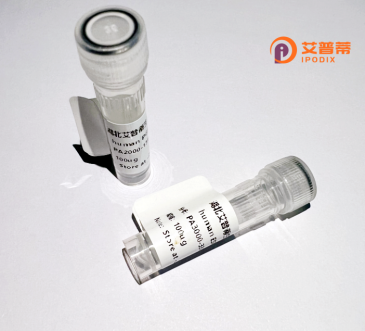
| 纯度 | >90%SDS-PAGE. |
| 种属 | Human |
| 靶点 | C9orf82 |
| Uniprot No | Q9H8G2 |
| 内毒素 | < 0.01EU/μg |
| 表达宿主 | E.coli |
| 表达区间 | 1-361aa |
| 氨基酸序列 | MTGKKSSREKRRKRSSQEAAAALAAPDIVPALASGSSGSTSGCGSAGGCGSVSCCGNANFSGSVTGGGSGGSCWGGSSVERSERRKRRSTDSSSVSGSLQQETKYILPTLEKELFLAEHSDLEEGGLDLTVSLKPVSFYISDKKEMLQQCFCIIGEKKLQKMLPDVLKNCSIEEIKKLCQEQLELLSEKKILKILEGDNGMDSDMEEEADDGSKMGSDLVSQQDICIDSASSVRENKQPEGLELKQGKGEDSDVLSINADAYDSDIEGPCNEEAAAPEAPENTVQSEAGQINDLEKDIEKSVNEILGLAESSPNEPKAATLAVPPPEDVQPSAQQLELLELEMRARAIKALMKAGDIKKPA |
| 分子量 | 64.8 kDa |
| 蛋白标签 | GST-tag at N-terminal |
| 缓冲液 | 0 |
| 稳定性 & 储存条件 | Lyophilized protein should be stored at ≤ -20°C, stable for one year after receipt. Reconstituted protein solution can be stored at 2-8°C for 2-7 days. Aliquots of reconstituted samples are stable at ≤ -20°C for 3 months. |
| 复溶 | Always centrifuge tubes before opening.Do not mix by vortex or pipetting. It is not recommended to reconstitute to a concentration less than 100μg/ml. Dissolve the lyophilized protein in distilled water. Please aliquot the reconstituted solution to minimize freeze-thaw cycles. |
(以下列举的参考文献针对C9orf72蛋白,假设您提及的C9orf82可能存在拼写误差,C9orf72是ALS/FTD神经退行性疾病研究中的关键蛋白。)
---
1. **文献名称**: *A Hexanucleotide Repeat Expansion in C9ORF72 Is the Cause of Chromosome 9p21-Linked ALS-FTD*
**作者**: Renton AE, et al. (2011)
**摘要**: 首次发现C9ORF72基因内含子中的GGGGCC六核苷酸重复扩增突变是家族性肌萎缩侧索硬化症(ALS)和额颞叶痴呆(FTD)的主要遗传病因,揭示了该蛋白与神经退行性病变的关联。
2. **文献名称**: *The C9ORF72 GGGGCC Repeat Is Translated into Aggregating Dipeptide-Repeat Proteins in ALS/FTD*
**作者**: Mori K, et al. (2013)
**摘要**: 揭示C9ORF72基因的异常重复序列可通过非经典翻译机制产生具有神经毒性的二肽重复蛋白(DPRs),如poly-GA、poly-GR等,这些蛋白可能通过干扰细胞功能加剧疾病进展。
3. **文献名称**: *C9orf72 disruption leads to dysregulation of autophagy and TDP-43 proteostasis*
**作者**: Amick J, Ferguson SM (2017)
**摘要**: 研究表明C9orf72蛋白通过调控自噬溶酶体通路参与细胞内稳态维持,其功能缺失会导致异常蛋白聚集(如TDP-43)及神经元变性,提示其在蛋白清除中的关键作用。
4. **文献名称**: *C9orf72 ablation causes immune dysregulation characterized by leukocyte expansion, autoantibody production and glomerulonephropathy in mice*
**作者**: Haeusler AR, et al. (2016)
**摘要**: 在小鼠模型中敲除C9orf72基因后,观察到系统性免疫异常,包括过度炎症反应和自身免疫疾病表型,提示该蛋白对免疫稳态的调控具有潜在影响。
---
以上文献均聚焦于C9ORF72蛋白的病理机制研究,涵盖遗传学、细胞生物学及免疫学领域。如需特定研究方向(如结构解析或新功能),请补充说明以便提供更精准的文献。
Recombinant human C9orf82 protein is a genetically engineered form of the protein encoded by the *C9orf82* gene, located on chromosome 9. Although its precise biological functions remain incompletely characterized, emerging studies suggest its involvement in intracellular processes such as vesicle trafficking, membrane dynamics, or signal transduction. The endogenous C9orf82 protein is widely expressed in tissues, particularly in the brain, implying potential roles in neuronal homeostasis. Structurally, bioinformatic analyses predict domains associated with protein-protein interactions or membrane binding, possibly localizing it to organelles like the Golgi apparatus or endosomes.
Research interest in C9orf82 has grown due to its genomic proximity to *C9orf72*, a gene strongly linked to amyotrophic lateral sclerosis (ALS) and frontotemporal dementia (FTD). While direct pathological links for C9orf82 remain unclear, interactions with proteins involved in autophagy or lysosomal regulation (e.g., SMCR8. WDR41) hint at overlapping pathways with neurodegenerative mechanisms. Recombinant C9orf82 enables functional studies, including binding assays, cellular localization experiments, and knockout/inhibition models to dissect its role in health and disease. Understanding C9orf82 may provide insights into conserved cellular processes and novel therapeutic targets. Further studies are needed to clarify its molecular interactions and physiological significance.
×